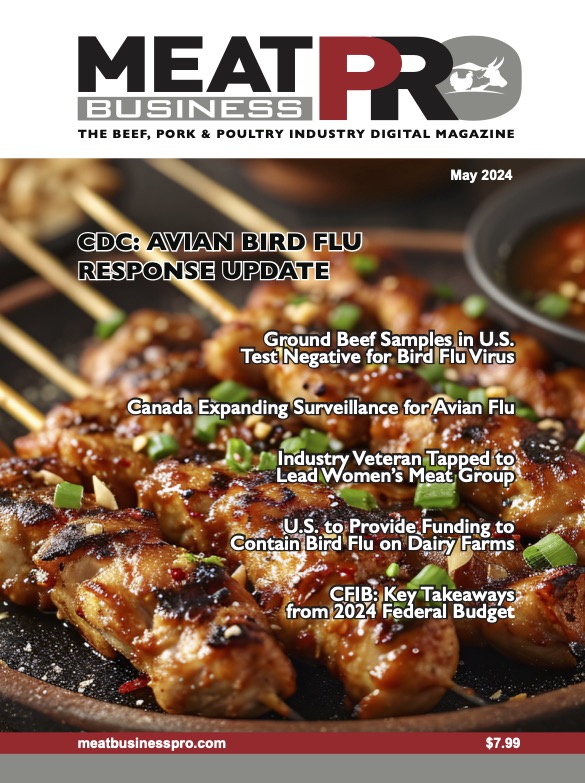Let’s Make a Deal

It might come as a shock to many Canadians, especially after all of U.S. President Donald Trump’s boasting about the issue, but the Canada-United States-Mexico Free Trade Agreement doesn’t actually exist. At least, not in reality. It’s still just a very good idea
by Scott Taylor – Canadian Meat Business
Oh sure, it’s been negotiated. Trump calls it the “greatest trade deal ever negotiated,” and, of course, refers to it as “the USMCA.” Trouble is, the CUSMA, as we call it here in the Great White North, hasn’t been ratified by any of the countries involved and for all intents and purposes, exists in name only.
That’s right, the current operating free trade agreement that exists among Canada, the United States and Mexico is still the North American Free Trade Agreement (1994). And it will remain in force until the Canadian Parliament, the congress of the United States and the government of Mexico say otherwise.
In the meantime, we remain a trading nation. In fact, it’s one of the things that drives the Canadian economy. When you do business in a country with only 35 million people, you must open outside markets in order to maximize your revenue opportunities.
“Currently, Canada has more than 90 Foreign Investment Promotion and Protection Agreements and Free Trade either in force or in negotiation”
And make no mistake, the Canadian meat industry is an important driver of Canada’s trade economy. According to the Ministry of Agriculture, in 2018, Canada exported $1.853 billion CDN in beef products to the United States and another $600 million to the rest of the world. As well, in 2018, Canada exported $1.165 billion CDN in pork to Japan, $1.153 billion CDN in pork to the United States, $455 million CDN in pork to China and $1.7 billion in pork products to the rest of the world.
In total, in 2018 alone, Canada exported more than $6 billion CDN in beef and pork products to the world.
The importance of strong trade agreements to the Canadian economy is quite obvious and that’s why the Canadian government is anxious to get the new CUSMA ratified and in force as quickly as possible.
However, that might not be possible.
There is little doubt the agreement will be ratified in Canada and Mexico. After all, taken in its full context, it’s a good deal for both countries. Trouble is, the U.S. Congress isn’t quite as enthusiastic as their country’s President.
In fact, late last month, one of U.S. Trade Negotiator Robert Lighthizer’s deputies told Fox News that he was quite optimistic that the “USMCA” would get through congress with, “huge bipartisan support by the end of April.” Many people laughed.
The comment was made by Republican attorney C.J. Mahoney, a member U.S. Trade Representative Robert Lighthizer’s staff. It’s very likely he’s either deluding himself, misleading the American people or speaking to an audience of one. And we all know who that one is.
Despite the fact the White House has reached out to some congressional representatives, there is no reason to think that the Democrats, who now control the U.S. House of Representatives, have told Lighthizer, Trump and NBC News that they won’t consider bringing the deal up for a vote until Trump lifts his tariffs on Canada’s and Mexico’s steel and aluminum.
Meanwhile, some Republicans oppose some very important aspects of the CUSMA, including its weakening of the NAFTA provision that lets foreign companies sue governments for mistreatment (Chapter 11).
Rep. Ron Kind (D), a member of the trade subcommittee of the Ways and Means Committee, told Axios that he gives Lighthizer credit for reaching out, but he added, “Like many of my colleagues, I won’t back the trade deal until Trump lifts those steel and aluminum tariffs. Retaliation for these tariffs is hurting Badger State (Wisconsin) farmers and manufacturers.”
However, Trump won’t budge. He “likes” tariffs, even when it hurts his allies and his own citizens.
“Time is of the essence,” Kind told Axios. “The later this issue drags into 2019, or if it slips to 2020, the presidential campaign is going to overwhelm things and make things so much more difficult to move forward.”Now, while Kind has his personal issues with the deal, it will ultimately be up to U.S. House speaker Nancy Pelosi to bring a vote on CUSMA to the House floor. And while she indicated to Axios that she’s open to Trump’s trade deal, Republicans anticipate she’ll use her leverage over Trump to extract something substantial in perhaps another area outside of trade.
Of course, the CUSMA is only one of more than 90 trade deals that Canada has in force around the world. The majority of those deals are single country-to-country agreements. It might surprise some Canadians to know that we have free trade agreements with Honduras, Guinea, Korea, Jordan and Peru and Foreign Investment Promotion and Protection Agreements with more than 80 countries.
However, there are five agreements, either in force or currently being negotiated, that involve more than one other country. In many cases, these agreements are worth billions of dollars to Canadian meat producers, grain producers, manufacturers and service providers.
As well, there is another major agreement that is currently in exploratory discussions – the potential Canada-China Free Trade Agreement. In 2016, Canada imported $48.6 billion US in goods from China and sent $16.3 billion back to China. China is now our second largest trade partner, next to the United States.
Canada-China Free Trade Agreement.
Status: Exploratory discussions
In force: No
Agreement type: Free Trade Agreement
Country grouping: China
According to the government, “Work on these discussions started in the fall of 2016 and face-to-face meetings took place from Feb. 20-24, 2017, in Beijing and from April 24-28, 2017, in Ottawa. A third set of meetings took place in Beijing from July 31 to August 4, 2017. The discussions gave both sides an opportunity to exchange information about each other’s regulations and laws, and to explore the details a possible Canada-China FTA.”
“It is a priority for the Government of Canada to expand trade and investment with large, fast-growing markets, including China,” said Canada’s trade negotiator Chrystia Freeland. “China is the world’s second largest economy, and Canada’s second largest single-country trading partner.”
Meanwhile, there are two other extremely important Canadian trade agreements that, along with the CUSMA, drive the largest portion of Canada’s international trade.
Comprehensive and Progressive Agreement for Trans-Pacific Partnership
Status: Signed
In force: No
Agreement type: Free Trade Agreement
Country grouping: Australia, Brunei Darussalam, Chile, Japan, Malaysia, Mexico, New Zealand, Peru, Singapore, Vietnam
According to the Government of Canada, “The Comprehensive and Progressive Agreement for Trans-Pacific Partnership (CPTPP) is a free trade agreement between Canada and 10 other countries in the Asia-Pacific region: Australia, Brunei, Chile, Japan, Malaysia, Mexico, New Zealand, Peru, Singapore and Vietnam. Once fully implemented, the 11 countries will form a trading bloc representing 495 million consumers and 13.5 per cent of global GDP, providing Canada with preferential access to key markets in Asia and Latin America.”
On Dec. 30, 2018 the CPTPP entered into force among the first six countries to ratify the agreement – Canada, Australia, Japan, Mexico, New Zealand, and Singapore. On January 14, 2019, the CPTPP entered into force for Vietnam.
The Canada-European Union Comprehensive Economic and Trade Agreement
In force: 2017-09-21
Agreement type: Free Trade Agreement
Country grouping: European Union (EU): Austria, Belgium, Bulgaria, Croatia, Cyprus, Czech Republic, Denmark, Estonia, Finland, France, Germany, Greece, Hungary, Ireland, Italy, Latvia, Lithuania, Luxembourg, Malta, Netherlands, Poland, Portugal, Romania, Slovak Republic, Slovenia, Spain, Sweden, United Kingdom (for now).
This is a progressive trade agreement that “upholds and promotes the values that Canada shares with the EU,” according to Trade Minister Jim Carr. It’s also a trade agreement with more than 500 million potential customers in the EU.
The agreement was signed on Oct. 30, 2016 and entered into force on Sept. 21, 2017 and since that time Canada has exported $46.8 million worth of goods and services to the EU, a one per cent increase (and growing) from pre-CETA days.
As well, Canada is involved in three smaller agreements that either have the potential to produce major markets in the future or have been consistently sound agreements since the day they were signed and ratified.
Canada-Pacific Alliance Free Trade Agreement
Status: Negotiations
In force: No
Agreement type: Free Trade Agreement
Country grouping: Pacific Alliance: Chile, Colombia, Mexico, Peru
According to the Alliance, “The Pacific Alliance is a regional integration initiative created in 2011 by Chile, Colombia, Mexico and Peru that seeks the free movement of goods, services, capital and people. The purpose of the Alliance is to promote greater competitiveness and economic growth for member countries, as well as to expand economic relations with the Asia-Pacific region.”
On June 29, 2017, at its Council of Ministers meeting attended by the Honourable François-Philippe Champagne, Minister of International Trade, the Pacific Alliance invited certain observer states (Canada, Australia, New Zealand, and Singapore), to become Associate Members. While Canada already has comprehensive and somewhat ambitious free trade agreements with all four Alliance members, Associate Membership would involve a new FTA with the Alliance as a bloc.
Canada-European Free Trade Association (EFTA) Free Trade Agreement
Status: In force
In force: 2009-07-01
Agreement type: Free Trade Agreement
Country grouping: European Free Trade Association (EFTA): Iceland, Liechtenstein, Norway, Switzerland
This free trade agreement between Canada and EFTA is a goods-only agreement with an emphasis on complete tariff elimination.
Canada-Mercosur Free Trade Agreement
Status: Negotiations
In force: No
Agreement type: Free Trade Agreement
Country grouping: Mercosur: Argentina, Brazil, Paraguay, Uruguay
Canada recently concluded exploratory discussions for a possible free trade agreement with what are known as the Mercosur countries: Argentina, Brazil, Paraguay and Uruguay. With a combined population of 260 million and a GDP of more than $3 trillion US, a new agreement would help increase Canada’s current $8.9 billion in bi-lateral trade.
There is very little doubt that Canada is a trading country. In 2017 alone, Canada exported $414.5 billion CDN in goods to the United States. That’s why the CUSMA is so important.
The market that was first created under the original NAFTA in 1994 now accounts for nearly 486 million consumers and a combined GDP of more than $22 trillion US. And, of course, the United States and Mexico are, respectively, Canada’s first- and third-largest merchandise trading partners in the world. Canada is, respectively, the second- and fifth-largest merchandise trading partner of the United States and Mexico, and the largest export market for the United States. In fact, $2.4 billion is goods and services cross the U.S.-Canada border daily.
The most important aspect of the CUSMA negotiations, at least for Canadians, was that Canada’s trade facilitators succeeded in preserving key elements of the original NAFTA (Chapter 19), including the cultural exemption and the use of binational panels to resolve disputes on duties. As well, Canada was able to eliminate Chapter 11, a section of the original NAFTA which allowed American companies to sue governments if a newly-elected government changed a law or delayed a purchase that directly or indirectly affected a private company’s bottom line.
Currently, Canada has more than 90 Foreign Investment Promotion and Protection Agreements and Free Trade either in force or in negotiation. However, the most important agreement is CUSMA.
Trouble is, only heaven and Nancy Pelosi know when that agreement will (ever?) get through Congress.












